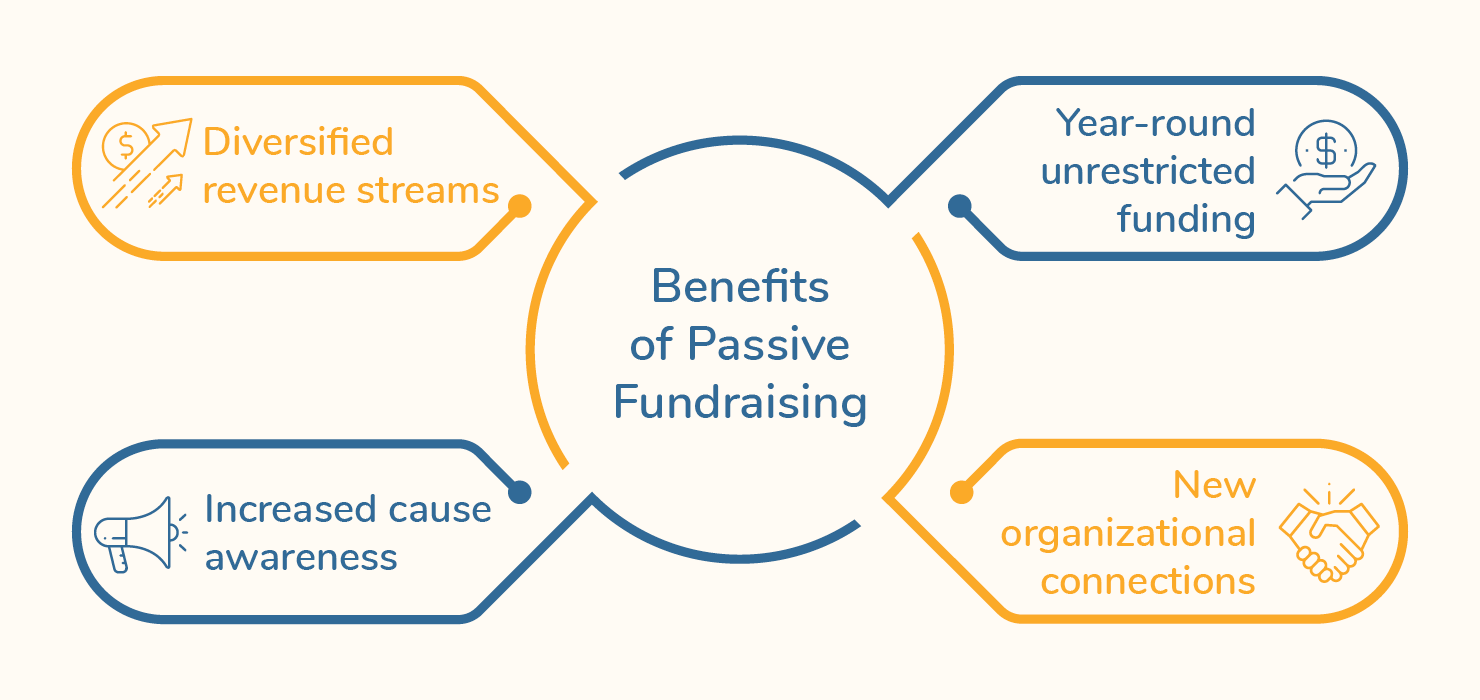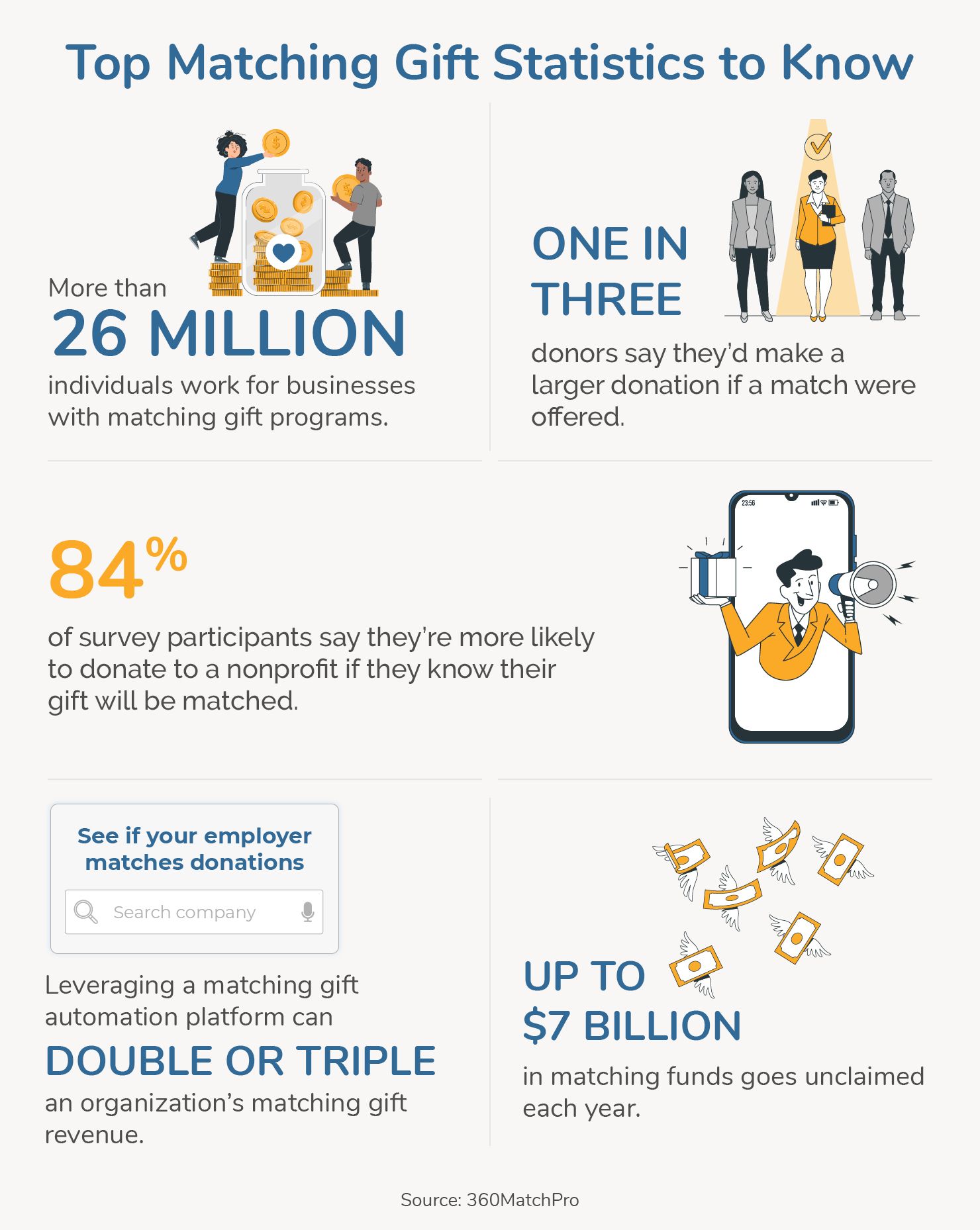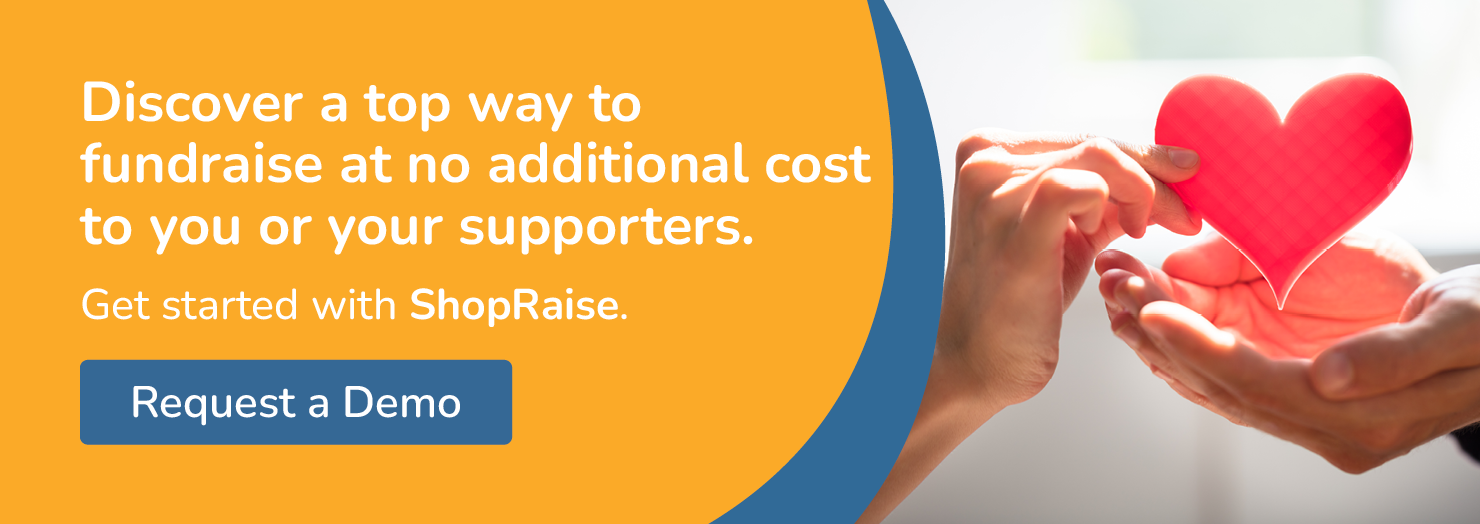For busy nonprofits, fundraising can quickly become a full-time job—on top of managing operations and running community programs. However, having a variety of revenue streams provides financial sustainability for your organization. So, how do you diversify your fundraising efforts without adding even more work to your team’s plate—or asking more of your generous supporters?
Fortunately, there is a solution that allows you to do just that: passive fundraisers! In this guide, you’ll learn everything you need to know to make passive fundraising work for your organization, including:
- What is passive fundraising?
- Benefits of Passive Fundraising
- Marketing Passive Fundraisers
- Best Passive Fundraising Ideas
It’s important to note that passive fundraising doesn’t just work for traditional 501(c)(3) nonprofits. Any organization that fundraises can benefit from this strategy, including schools, associations, sports teams, community groups, and faith-based organizations. If your organization falls into any of these categories, let’s dive in!

What is passive fundraising?
The term “passive fundraising” refers to any campaign in which supporters generate revenue for charitable causes as they go about their daily activities, often without spending any money they wouldn’t have otherwise. Because of this, each contribution to a passive fundraiser tends to be small, but these funds add up over time!
On the organizational side, the “passive” aspect is that once these campaigns are set up, running them is relatively hands-off. Note that successful passive fundraisers aren’t 100% passive—your nonprofit still needs to take a few active, peripheral steps to make the most of them, including marketing, tracking results, and thanking participants. However, these campaigns still require less work than adding another event or traditional fundraiser to your calendar.
Benefits of Passive Fundraising
Besides the relative ease of running them, your nonprofit can experience several other benefits by incorporating passive fundraisers into your strategy, including:

- Diversified revenue streams. As mentioned previously, receiving funds from a variety of sources and campaigns (including passive fundraisers) creates a more stable financial foundation for your organization. If your expenses are higher than expected or a funding source falls through, passive fundraising revenue can help your nonprofit recover more quickly.
- Year-round unrestricted funding. Passive fundraisers are usually ongoing once they’re set up, so you can bring in reliable funds between your larger campaigns and events. Plus, you can put the revenue from most passive fundraisers toward any area of your nonprofit’s budget, including necessary but often underfunded overhead costs.
- New organizational connections. Most passive fundraisers require you to partner with one or more external businesses, which can lead to long-term, mutually beneficial relationships between them and your organization.
- Increased cause awareness. In a similar vein, existing customers or employees of your passive fundraising partners may hear about your nonprofit for the first time because of your campaign and be motivated to get involved with your mission in other ways.
The businesses who support your passive fundraising efforts also benefit, since being involved with charitable causes boosts their reputation as socially responsible organizations and allows them to give back to the communities that help them thrive. This combined with the advantage for individual supporters of not having to go out of their way or spend extra money to contribute to your nonprofit makes passive fundraising a win-win-win situation!
Marketing Passive Fundraisers
Once your passive fundraisers are up and running, the most active part of the process for your nonprofit will be promoting them. Some of your supporters likely won’t have participated in this specific type of campaign before, so they’ll need instructions to get started. Plus, all of your supporters will benefit from recurring reminders to contribute!
Leverage the following channels to market your passive fundraisers:

- Your organization’s website. Create individual pages dedicated to each of your nonprofit’s passive fundraisers that explain all of the campaign’s key details. If your fundraiser has a separate landing page or donation form that supporters will use to contribute, link to it on the information page.
- Search ads. Google offers an Ad Grant program through which eligible nonprofits can receive $10,000 in monthly advertising credits to drive more search-related traffic to their websites. If your organization applies and is approved for the grant, you can use your credits to promote nearly any initiative that is important to your strategy—including your passive fundraisers!
- Social media. Every social media platform has different conventions, so make sure your passive fundraising announcements and reminders align with the site’s format. For example, you might organize the same information into a text-based post for Facebook, a series of graphics for Instagram, and a short video for TikTok.
- Email marketing. If your organization sends out a monthly or quarterly newsletter, include blurbs about your passive fundraisers in it as well as sending dedicated emails to promote individual campaigns.
- Flyers. Print marketing materials are a great supplement to digital communications, especially if they have eye-catching designs! Hang flyers advertising your passive fundraisers at your organization’s facility and your partner businesses (with their consent), and consider mailing them to individual supporters as well.
Make sure to incorporate your nonprofit’s branding across all of these marketing channels, as well as your passive fundraiser landing pages. When supporters see your logo, color scheme, and consistent messaging style across all of your promotions, it creates a sense of trust that helps inspire them to participate in your campaigns.
Additionally, when choosing a business or fundraising program to partner with for your passive fundraiser, look into whether they’ll provide marketing support for your campaign. Depending on their model, some partners will offer co-marketing opportunities or even create some promotional materials for you.
Best Passive Fundraising Ideas
Every organization is unique and will therefore benefit from a different approach to passive fundraising. Before you launch any campaign, research solutions and partners to find the best fit for your nonprofit.
To help you get started, here are seven of our favorite passive fundraising ideas:
Online Shopping Fundraisers
Online shopping fundraisers allow supporters to contribute to your nonprofit by making everyday purchases at participating e-commerce businesses. A portion of their total sale goes directly to your mission at no additional cost to them or your organization!
To launch an online shopping fundraiser, your nonprofit will need to partner with a platform like ShopRaise. ShopRaise operates within a wide network of popular online retailers and handles all necessary business negotiations for participating organizations. The only difference for supporters is that they’ll go through the ShopRaise app or browser extension to make their purchases.
Your organization can get started with ShopRaise in three easy steps:

- Sign up for ShopRaise. Our fundraising experts will walk you through a simple onboarding process, answer any questions you might have, and even create a branded landing page for your nonprofit.
- Spread the word. ShopRaise can also help your nonprofit design branded email templates, flyers, website banners, and other marketing materials to encourage supporters to shop for your cause.
- Track results. You’ll be able to view real-time data on your fundraiser as it progresses, allowing you to thank your top supporters individually and hone your marketing strategy. ShopRaise protects shoppers’ privacy by only allowing your organization to see their names and fundraising totals—only the supporter will know exactly what items they purchased.
When supporters participate in your online shopping fundraiser, they’ll pay the same prices and have access to all of the discounts they would have otherwise. They can also view their fundraising totals in the ShopRaise app, so they’ll see how their shopping adds up to significant contributions to your organization over time!

Gift Card Fundraising
Another way supporters can contribute to your nonprofit by making everyday purchases is through gift card fundraising. Similar to an online shopping fundraiser, shoppers buy gift cards from their favorite retailers, and a portion of each sale goes back to your organization.
If your organization registers for ShopRaise’s online shopping fundraiser, you’ll automatically gain access to the platform’s Gift Card Store as well! Your supporters can choose from more than 200 different gift cards, and your organization will receive 5.5% of their sales total on average.
ShopRaise provides all gift cards in a digital format, so they’re delivered directly to supporters’ inboxes within minutes of purchase. Once they receive their digital gift card, they have three options for what to do with it:
- Forward the email to a friend or family member to give them the card as a gift.
- Use the card for their own in-store or online purchases so they can give back while they shop or eat out.
- Pay for the items they buy through ShopRaise’s online shopping fundraiser feature with the gift card, thereby contributing even more to your organization!
You’ll get the most traction from your gift card fundraiser if you launch in either November (in advance of the December holiday season) or April (to prepare for Mother’s Day, Father’s Day, peak wedding season, and school graduations). However, the ShopRaise platform allows your organization to bring in reliable revenue from both online shopping and gift card fundraising year-round. Supporters will likely need to buy birthday gifts at various times of the year, and they can use the cards for their own purchases at any time as well.
Fundraising eCards
If your supporters purchase fundraising gift cards for their friends and family members, they might also want to send them a greeting card to celebrate the special occasion. With fundraising eCards, they can do just that while contributing even more to your nonprofit!
Follow these three simple steps to incorporate fundraising eCards into your organization’s strategy:
- Create a variety of eCard designs. Find a user-friendly online greeting card platform that allows you to design eCards for all kinds of occasions—birthdays, holidays, anniversaries, graduations, thank-yous, and more. Brand the cards to your nonprofit so that supporters can help spread awareness of your cause by sending them.
- Embed the cards into your nonprofit’s donation page or sell them in your online store. Either way, supporters should have to contribute a small minimum amount to send an eCard, which they can think of as replacing the money they would likely have spent on a paper greeting card at a store.
- Promote the fundraiser. Similarly to gift card fundraising, supporters can purchase some types of fundraising eCards year-round. However, consider marketing more heavily before holidays to advertise any new designs you have available for that specific occasion.
If you need some inspiration for your organization’s fundraising eCards, check out these (adorable!) examples designed by One Tail at a Time:

Restaurant Sponsorships
If your supporters enjoy eating out, consider partnering with one of their favorite local restaurants for a sponsorship program!
The most common type of restaurant sponsorship is profit sharing, where the restaurant donates a portion of the profits they earn on designated days to your organization. Also, fast-food restaurants and coffee shops sometimes display donation tip jars at the register where customers can contribute their spare change.
There are two main ways your nonprofit can set up a restaurant sponsorship:
- Apply to an existing sponsorship program. Many large restaurant chains, including Panera Bread, Panda Express, and Chipotle, have fundraising programs where they set up profit shares with nonprofits. This method is the more streamlined route, but these types of programs often only accept applications from well-established organizations.
- Contact a locally owned restaurant. If you know that many of your supporters like to eat at a particular spot in town, or a local restaurant has connected with your organization in the past, setting up a profit share with them might be the best route. You’ll need to negotiate the sponsorship terms yourself, but this method can work for organizations of all sizes.
As soon as you know when your profit share will take place, start promoting it to your supporters so they can make sure to go to your chosen restaurant on the right day. If you also run a gift card fundraiser through a platform that sells gift cards to that restaurant, encourage supporters to buy one before they attend the profit share (or even during, if you use a quick-delivery digital gift card fundraising solution like ShopRaise) so they can increase their contribution!
Grocery Store Fundraising Programs
Like with restaurant sponsorships, grocery store fundraising programs can operate in a few different ways. To contribute, customers might be asked to:
- Choose a nonprofit in the store’s partner network to receive a percentage of their purchases when they use their rewards card
- Round up their sales total for charity before selecting a payment method
- Add a piece of merchandise to their order as an in-kind gift to a designated organization
Grocery store fundraising programs are extremely convenient for supporters—after all, almost everyone buys groceries! However, details and benefits vary widely depending on the chain. Thoroughly research the fundraising programs offered in your area before choosing one and encouraging your supporters to take their business there to support your organization.
Charitable Brand Lines
Sometimes brands produce product lines and dedicate a portion of their proceeds to a nonprofit. In most cases, these lines help support large organizations they have relationships with to provide the retailer with increased brand visibility and a reputation boost.
Charitable brand lines can be a great opportunity for shoppers if they are interested in the specific product or service. For example, if someone really wants to buy a beaded bracelet as a gift for a friend, purchasing one with beads made of recycled plastic where the proceeds go to an organization that removes trash from the ocean is a great way for them to shop more ethically.
Charitable brand lines tend to be specific to a few products and may not always align with your supporters’ regular shopping lists. But if your nonprofit ever has the opportunity to earn revenue from a brand line, it can help you secure a long-standing corporate sponsorship that leads to other future benefits.
Matching Gifts
Matching gifts are a bit different from the other passive fundraising ideas in this guide, but they’re still an effective and easy revenue stream for your organization to leverage. Instead of contributing to your nonprofit by buying products they likely would have anyway, they get to multiply the donations they were already planning to make without giving any more out of their own pockets!
When a supporter who works for a business with a matching gift program donates to your organization and submits a match request, their employer will also contribute, usually matching the original gift at a 1:1 ratio. Besides doubling the impact of individual donations, here are some additional statistics to demonstrate matching gifts’ value, as reported by 360MatchPro:

- More than 26 million individuals work for businesses with matching gift programs, meaning some of your nonprofit’s existing supporters are likely among this number!
- 84% of survey participants say they’re more likely to donate to a nonprofit if they know their gift will be matched.
- One in three donors say they’d make a larger donation if a match were offered.
- Leveraging a matching gift automation platform can double or triple an organization’s matching gift revenue. (Pro tip: Look for a platform with auto-submission capabilities, so all donors have to do to submit a match request is enter their work email address. This makes your fundraiser even more “passive” while leading to more completed matches!)
However, the report linked above also estimates that up to $7 billion in matching funds goes unclaimed each year, mainly because many donors don’t know they’re eligible. To help solve this problem, promote matching gifts as you would your other passive fundraisers, and embed your matching gift tool directly into your online donation form so supporters can quickly check their eligibility and submit requests.
Wrapping Up: Additional Resources on Passive Fundraising
With a bit of strategizing and effective marketing, passive fundraisers can help your nonprofit bring in extra revenue throughout the year. Find a program that aligns with your organization’s fundraising goals, then work alongside your partners in fundraising to promote your campaign, track its results, and thank the supporters who make your success possible.
For more information on passive fundraising, check out these resources:
- Starting a Gift Card Fundraiser: The Complete Guide. Dive deeper into the process of launching a gift card fundraising campaign and learn how to tailor it to your organization.
- 20+ Holiday Fundraising Ideas for a Merry and Bright Season. Discover our top picks for both passive and active fundraisers associated with the December holiday season.
- Charity Affiliate Programs: 10 Best Options to Earn More. Explore the world of affiliate fundraising, which overlaps slightly with passive fundraising in both purpose and execution.


